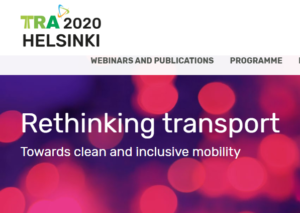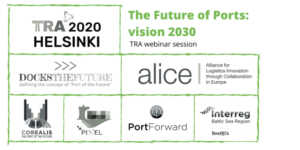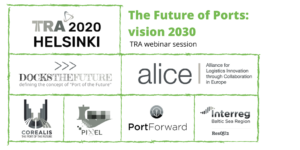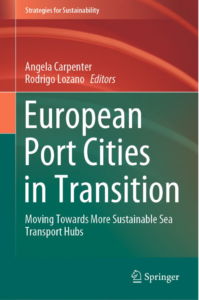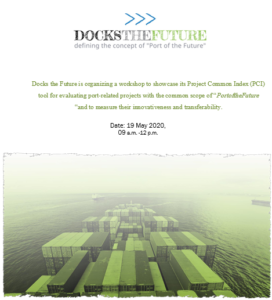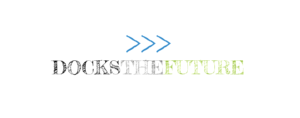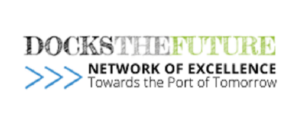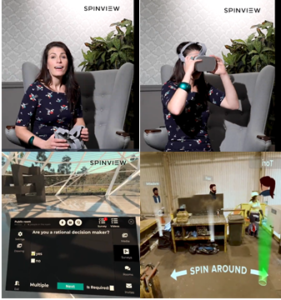The second International Consultative Committee’s meeting of the DocksTheFuture project took place on 28 April 2020 between 10-11.
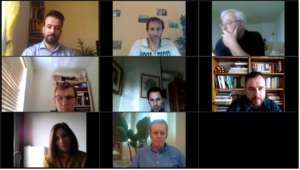
The Objective of the conf.call was: How to develop the “ Relation with Med & Neighbouring Countries”, and to add a specific chapter on this topic to the Deliverable D.5 of the project. For this purpose, four below areas suggested to be at the centre of discussion:
Current ports’ Policies in Mediterranean basin, cooperation or competition?
How Med ports will face the environmental challenge, moving towards sustainability?
How to proceed with capacity building for the less developed ports in the Med region?
The best practices of successful maritime and port projects in the Med region.
The partticipants of this meeting were from four groups of:
o ICC members: Michele Acciaro, Paul Brewster,
o MEDport Association: Luca Lupi, Gabrielle Charpentier
o WestMED Initiative: Javier Fernandez
o Docks The Future (DTF) project’s partners: Circle s.p.a: Mr.Karimpuor, Alexio Picco, Beatrice Dauria, PortExpertise group: Joris Claeys, Peter Bresseleers , Magellan Association: Manuela Flachi
Mr.Alexio Picco from Circle s.p.a that leads the project welcomed the participants of the meeting and explained about the project and its progress. He also pointed out how to proceed organising the 3rd expert workshop in this pandemic days.
Mr.Karimpour from Circle s.p.a presented the Docks The Future, and the Structure of the meeting. He gave a brief introduction to the project that DTF is a project funded by the European Commission under Horizon 2020. As a Coordination and Support Action (CSA) it will support the EC (DG MOVE and INEA) in covering coordination and networking of Research and Innovation projects, Programs and policies. The project is coordinated by Circle S.p.A (Italy) as the leader of the Working Group including: ISL – Institut für Seeverkehrswirtschaft und Logistik (Germany), Magellan (Portugal), PortExpertise (Belgium) , University of Genoa (Italy).
Then, the Current conditions of the Docks The Future for the below workpackages explained in short: WorkPackage.1: Definition Of The Concept, WorkPackage.2: Clustering Of Projects, WorkPackage.3: Evaluation Analysis, WorkPackage.4: Dissemination, WorkPackage.5: Plan For The Exploitation Of The Results.
In continuation, Mr. Karimpour mentioned that DocksTheFuture has already addressed in early stages of the Project: preliminary research on the “Port of Future” concept; and the definition of several “Port of the Future topics” to be addressed and their related targets in 2030;
o Port infrastructure
o Accessibility and Standards
o Integration in the supply chain and synchromodality
o Environment
o Sustainability
o Relation with Med & Neighbouring Countries
o Digitalization
o Port-city relations
o Governance
o Human element
o Safety & security
o Bridging R&D and implementation
In WP.1 Docks The Future performed the work on essential concepts of a port of the future. Deliverable 1.5 of the project: Port of the Future concepts, topics, and projects,desktop analysis lead by PortExpertise, has already touched the topic of “Relation with Med & Neighbouring Countries”, some of them listed below.

Some of the references of PortExpertise for this Deliverable have been “Port Cooperation Policies in the Mediterranean Basin: An Experimental Approach Using Cluster Analysis”’, “Challenges for the future of ports. What can be learned from the Spanish Mediterranean ports? “, “Port-2-Port Communication Enabling Short Sea Shipping: Cyprus and the Eastern Mediterranean”, and “ Port Collaborative Decision Making (PortCDM) project.”
Later on, the Objective of the conf.call highlighted: How to develop the “ Relation with Med & Neighbouring Countries”, and the four below areas suggested to be at the centre of discussion after the MEDport presentation.
Current ports’ Policies in Mediterranean basin, cooperation or competition?
How Med ports will face the environmental challenge, moving towards sustainability?
How to proceed with capacity building for the less developed ports in the Med region?
The best practices of successful maritime and port projects in the Med region.
Mr. Luca Lupi , Secretary General of the MEDport Association, presented the Association as per below. The MEDports Association is the result of the desire and necessity to ensure port and maritime cooperation between the southern and northern banks of the Mediterranean.
• 23 Port Authorities, 3 Associated Members, 6 Objectives, 6 Technical Committees
23 Port Authorities and National Port’s Agencies from Northern (15) and Southern banks (8) in SPAIN, ALGERIA ,FRANCE ,ITALY ,MOROCCO ,TUNISIA ,LEBANON,SLOVENIA ,MALTA ,GREECE. Furthermore, MEDport has 3 Associated Members from Northern (1) and Southern banks (2), and 5 Training Institutes from Northern (3) and Southern banks (2) associated to the works of the MEDports Association. Luca stated the MEDport objectives.
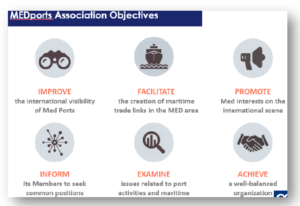
Later it was emphasized that the North-South Med cooperation is at the center of focus for the associations’ activities. There are committees in the association for the internal works: RII Committee: Relations with International Institutions, Smartport Committee, SMA Committee: Statistics and Market Analysis, Security & Safety Committee, Sustainability Committee, and ETME Committee Employment, Training and Maritime Expertise.
He added that there are Actions within MEDports such as Signing MoU with the Union of the Mediterranean (UfM) and MED CRUISE, Organizing Training Seminars for trainees from both banks. MEDport is also active in international events and projects. MEDports Association Forum (MPF) conducts activities like Annual event bringing together experts, ports, and actors from the maritime sector of the two Mediterranean banks based on a topic which welcomes the needs and interests of all Members.
Furthermore, it is highlighted the MEDport contribution to some regional projects such as:
The Young Employment in Ports of the Mediterranean (YEP-MED); Better match labour supply with labour demand in the Med area
RMF2M project ; Réseau Méditerranéen de Formation aux Métiers Maritimes (RMF2M), Mediterranean Network Occupations Of Training Program, an Intelligent platform that will summarize the training formations and job offers to correspond to a profile
In the end, it is explained that DocksTheFuture & MEDports Association can have cooperation and collaboration in many common fields of activities, a Win-Win cooperation. It could be listed but not limited to the following points :
Access to the largest current Ports Network in the Med area
Exchange best practices from our Members
Take advantage of the work of the internal Committees, especially from the Smartport and Training Committees
The MEDPorts Association highlights the problems of the ports of the South to the EU, especially through the RII Committee
At this stage, the ICC members entered the discussion on the topic with the MEDport invitees. Mr. Acciaro asked if MEDport have some kind of information on the currently funded projects in terms of collaboration among the European Ports, or Mediterranean ports?
Mr. Lupi replied that MEDport is working on that it is very important to work together to solve the problems and it is one of the reasons to set up the association. At this stage, Mr.Javier Fernandez from the West MED initiative said that the maritime cooperation and initiatives have been at the focus of attention by the EU. Basically this maritime initiative has been working for a couple of years with strong leadership from member countries that sit together every 2-3 months in the framework of the
the steering committee and in December 2018 in Algeria meeting, they set up a road map for sustainable development of Blue Economy in the West MED area.
One of the cores of this roadmap is the “Cooperation” between the states in the region. For West Med, it is important to develop North-South cooperation too and is really relevant. West Med has managed to support 12 projects in the region, and working in this context of the DocksTheFuture is really welcomed and valuable. He proposed two points:
1. The cooperation and participation from the DocksTheFuture for the next forthcoming steering committee in Malta, and the other one
2. Each of the partners of the technical groups of the sustainable transport framework has two representatives: one from institutes and one from the industry. The national hubs are working with these two representatives. So for the DocksTheFuture and MEDport will be an opportunity to be in contact with these technical groups and the representatives.
Mr. Acciaro asked if the sustainable transport scope of the West Med includes maritime transport, and the reply was yes. Mr.Javier also mentioned that it is just initiated, it also may anticipate the topics of the LNG and the on the motorways of the seas.
Mr. Alexio said that if any of the participants can mention one point to focus at this step for the cooperation in the scope of the ports in North and South. Ms. Charpentier from MEDport agreed with the MEDport perspective. Manuela from Magellan highlighted the communication. Beatrice from Circle stated that finding the right contact and getting in touch with the correct contacts at the ports of the Med region is very difficult. It could be one of the challenges for further cooperation in the future. Mr. Joris Claeys, also added that this topic is also related to the “Network of the Excellence”. He also added that as Reza bolded, one of the important points is sharing the best practices among the states and ports in the MED area and also the EU.
Mr. Brewster, the ICC member also acknowledge Mr. Joris’ statement on the importance of a sort of a network; the “Network of Excellence”, to be a collaborative network. The point is a “Balance “between cooperation and competition.
Mr. Javier, also mentioned that the maritime initiatives are a collaborative type between the countries, sometimes partnership in preparing the proposals, competition have not been seen yet in the West Med.
Mr. Acciaro stated that it is very valuable to have the WestMED initiative and the MEDport association because the collaboration between the Mediterranean countries have not yet produced the desired results, as the EU should cooperate more with MED Countries. Potential improvements in the cooperation are known in the case of China but more can be done also in the Mediterranean area. There is an urgent need for more collaboration in the Med area. He suggested to include other countries in initiatives such as Turkey, or even the UK. In continuation, he added that when we talk about the European ports there are right concerns that EU regulations in the ports might constrain the developments of EU ports, and damage their competitiveness with respect to some business segments in other regions, for example in transhipment and in cruise sector in countries such as Russia, Egypt, or Turkey, which should adopt similar rules as EU ports.
Harmonising funding and policy were discussed. It would be valuable to consider also potential relations with the Belt and Road initiatives in terms of improving coordination of global maritime transport networks with EU internal transport networks. He added that compared to the Med ports in the south of EU, in Northern Europe there are more measures in terms of technology and innovations such as Onshore Power Supply, programmes to advance Hydrogen, and low carbon alternative fuels. He thinks that collaboration in Mediterranean level and applying the best practices across the European ports can help a lot also Med ports
Mr. Picco put a comment that there will be a good big project of onshore-power supply that is in evaluation within the motorways of the sea, in the Med area, and other forthcoming initiatives and projects as a good opportunity for the collaboration between the MED ports and the West Med initiative. Mr. Bresseleers in continuation joined the discussion and left his comment. He said that they captured a lot of info from the Med ports and he is wondering why there is so much internal communication in Med ports, which not reaching out to other ports. The port of Antwerp had a webinar on Covid19, one of the issues about the ships coming from Med region to Antwerp and the required Sanitation Certificates. So it shows that cooperation is more needed between ports even more than before.
In the end, Mr. Picco summarised the conclusion that we are going to plan how to go more in the analysis of this topic, and for sure we will come back to the participants of the 2nd ICC meeting to use their valuable comments to develop our specific chapter on the relation with the Neighbouring countries.
It also emphasized that DocksTheFuture is going to use the capacity of these two initiatives to develop a specific chapter on “Relation with Med and neighbouring countries”. For this purpose, DocksTheFuture is going to keep contacts with these two initiatives and regularly attend the forthcoming physical or online events of the MEDport Association & WestMED Initiatives in order to gather the info and feedback. In addition, DocksTheFuture will connect to all social media (Twitter, FB, LinkedIn) of MED port & WestMed Initiatives to disseminate each other’s activity on the same topic.
As the next step, for developing the specific chapter on the “Relation with MED and neghbouring countries” within the project, DocksTheFuture is going to send Questionnaire to the Med Ports & West Med members on some relevant group of topics such as Current port Policies in Mediterranean basin, best mechanisms of cooperation among Med ports, top challenges in the Med ports in moving towards Sustainability, capacity building in the Med region’s ports, identifying the best practices from other EU ports to be implemented for the MED ports, the potential of the Port-2-Port communications for enabling Short Sea Shipping between the Med ports, and etc.
Furthermore, inviting the experts from these two initiatives for the DTF expert call and the final conference is one of the measures to help DocksTheFuture in developing the specific chapter on “Relation with Med & Neighbouring countries”. This specific chapter may include other measures like interviews with some port managers of non EU-Countries (for example in Turkey, Egypt, Algeria, Morocco, Russia, etc.), and also approaching the successful European regional maritime & port organizations like HELCOM in the Baltic region in terms of their cooperation with non-European states (such as Russia) in order to simulate for the Mediterranean ports in relationship with Non-EU ports in Northern African and also Black Sea areas. Furthermore, one of the steps can be exploring the mechanism for involving the East Adriatic Sea ports such as Albania, Bosnia, and Montenegro in further cooperation with European Ports and maritime projects to reach the standards of the European regulations, through the EU funds and capacity building.
